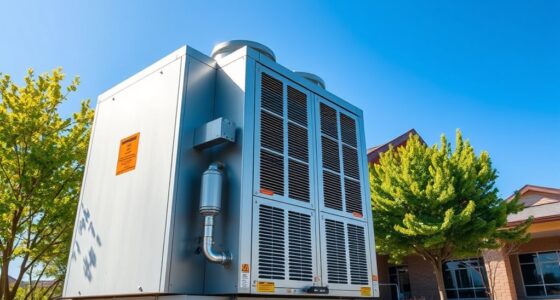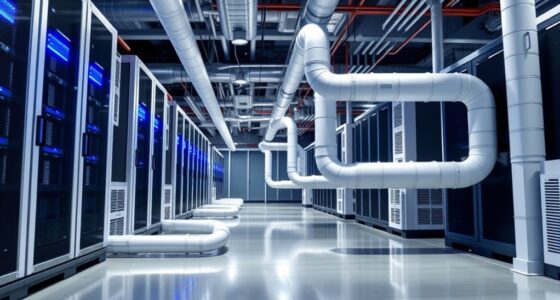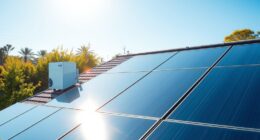Retrofitting apartment blocks with heat pumps offers many benefits, like reducing your building’s carbon footprint, supporting renewable energy use, and increasing tenant comfort. However, you need to navigate challenges like structural limitations, preserving historic features, and upgrading existing infrastructure. Proper planning, securing funding, and engaging residents are key steps to success. To learn how to overcome these obstacles and ensure long-term system performance, keep exploring the essential guidance ahead.
Key Takeaways
- Conduct thorough structural and infrastructural assessments to ensure compatibility with heat pump systems.
- Engage residents early to explain benefits, address concerns, and facilitate smooth implementation.
- Plan phased installations to minimize disruptions and coordinate with relevant permits and regulations.
- Explore financial incentives, grants, and financing options to support retrofit costs and maximize sustainability.
- Establish ongoing maintenance routines and smart control systems to ensure long-term efficiency and performance.
Understanding the Benefits of Heat Pumps in Multi-Unit Buildings
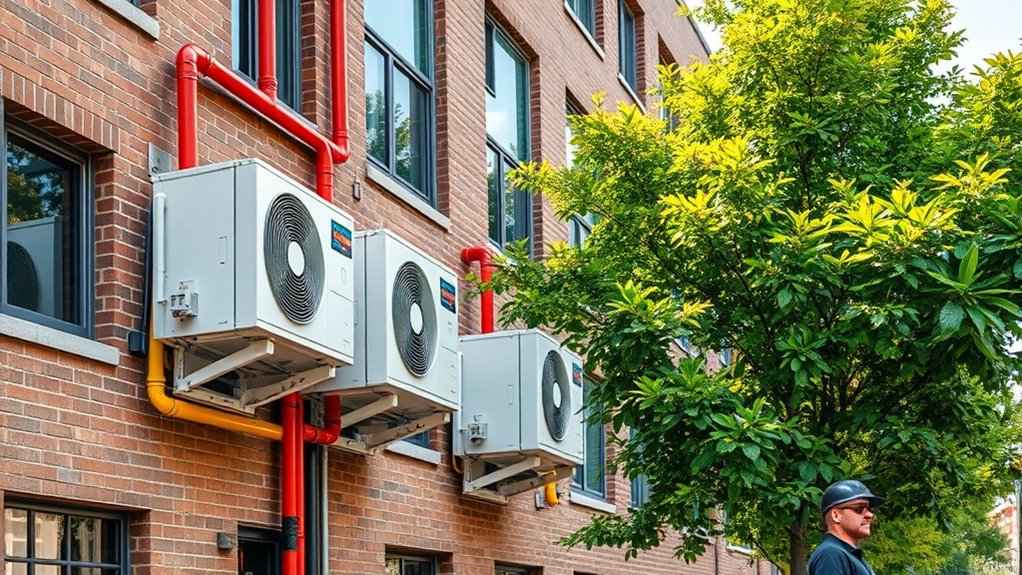
Heat pumps offer several compelling benefits for multi-unit buildings, making them a smart choice for retrofitting. They support renewable integration by efficiently utilizing electricity, which can be sourced from renewable sources like wind or solar, reducing your building’s carbon footprint. This shift not only aligns with sustainability goals but also helps future-proof your property against evolving regulations. Additionally, heat pumps foster tenant engagement by providing reliable, consistent heating and cooling, enhancing comfort and satisfaction. When tenants see your commitment to green technology, they’re more likely to appreciate and support energy-saving initiatives. Moreover, modern heat pumps are designed with noise reduction technology, ensuring quiet operation that won’t disturb residents. Overall, heat pumps offer an effective way to modernize your building, promote sustainability, and strengthen tenant relationships—all essential for the long-term success of your property.
Assessing the Challenges of Retrofitting Older Apartment Blocks
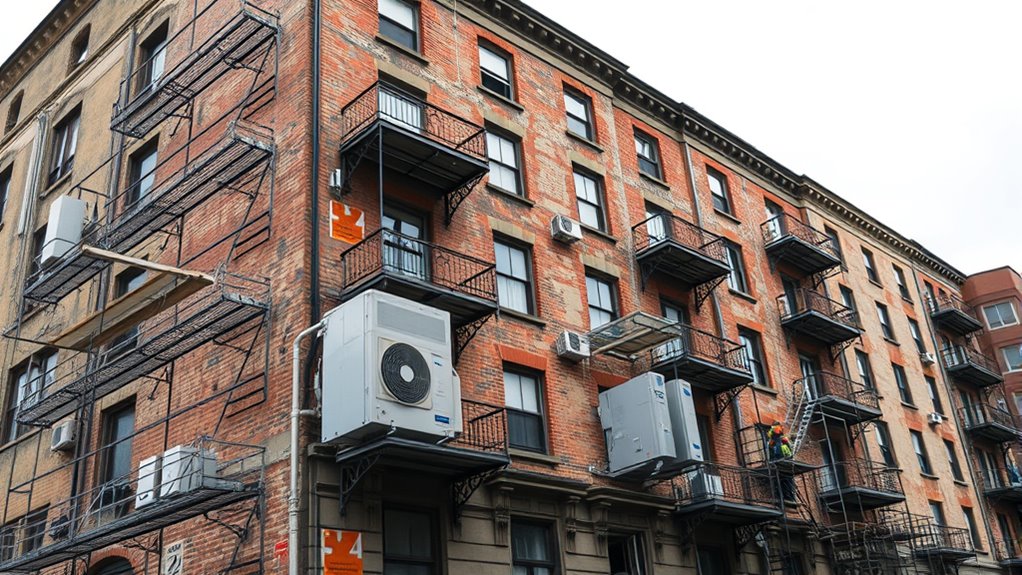
When retrofitting older apartment blocks, you’ll face structural limitations and constraints that can complicate installation. Preserving historic features adds another layer of challenge, often requiring careful planning and approval. Additionally, infrastructure compatibility issues may arise, making it harder to integrate modern heat pump systems seamlessly. Being aware of conflict resolution skills can aid in navigating these challenges effectively.
Structural Limitations and Constraints
Retrofitting older apartment blocks with heat pumps presents significant structural challenges that can complicate installation efforts. You need to carefully evaluate the foundation integrity to guarantee it can support additional equipment and loads. Many older buildings have weakened or uneven foundations, which may limit where and how heat pumps can be installed safely. The load bearing capacity of walls and floors also matters—some structures weren’t designed to handle the extra weight or vibrations caused by modern heat pump systems. Before installation, thorough assessments are essential to identify any structural weaknesses. You might need to reinforce or modify certain parts of the building to prevent damage or failure. Addressing these limitations upfront helps ensure a safe, effective retrofit without compromising the building’s stability. Additionally, understanding the structural limitations of the building can inform more effective retrofit strategies and prevent costly modifications later on.
Historic Preservation Challenges
Evaluating the challenges of retrofitting older apartment blocks involves managing strict preservation rules and maintaining historic integrity. You need to balance modern upgrades with architectural preservation, ensuring that any modifications don’t compromise the building’s original character. Preserving historical accuracy is essential, especially when working with heritage-listed structures or those with significant architectural value. You’ll face regulations that restrict alterations to facades, windows, and decorative features, requiring sensitive planning and approval processes. Retrofitting with heat pumps must be done carefully to avoid damaging historic elements. This often limits the options for installing new systems, forcing you to find innovative solutions that respect the building’s original design. Ultimately, you must prioritize both energy efficiency and the preservation of the building’s unique historic features. Additionally, understanding the specific bedroom design elements can aid in planning interior modifications that complement the building’s historic character while integrating modern systems.
Infrastructure Compatibility Issues
Addressing infrastructure compatibility issues in older apartment blocks requires careful evaluation of existing systems and structural constraints. You’ll need to identify whether current electrical, plumbing, and ventilation setups support heat pump installation and renewable integration. Structural limitations might mean redesigning ductwork or upgrading insulation. Tenant engagement is vital; residents need to understand how these changes affect their living spaces and energy use. Here’s a quick overview:
| Challenge | Solution |
|---|---|
| Outdated electrical wiring | Upgrade circuits for increased load |
| Limited space for equipment | Reconfigure layouts or select compact units |
| Insufficient insulation | Retrofit with better insulation options |
| Compatibility with renewable systems | Integrate smart controls for efficiency |
Planning and Designing an Effective Heat Pump System

To design an effective heat pump system for apartment retrofits, you need to start with a thorough understanding of the building’s heating and cooling loads. This helps you determine the right size and capacity of the system. Incorporate smart controls to enhance efficiency and user comfort, allowing for precise temperature management. Zoning strategies are essential; dividing the building into separate zones lets you heat or cool specific areas based on occupancy and needs, reducing energy waste. Consider how control systems can integrate with existing building management infrastructure to optimize performance. Proper planning guarantees the system is tailored to your building’s unique requirements, maximizing energy savings and occupant comfort while minimizing operational costs. Additionally, understanding industry trends can help you select the most innovative and effective solutions for your retrofit project.
Navigating Funding and Incentive Opportunities

Securing funding and incentives is a crucial step in retrofitting apartment buildings with heat pumps, as it can substantially reduce upfront costs and improve project feasibility. Exploring various financing options and incentive programs helps you maximize financial support. Many governments and utilities offer grants, rebates, or tax credits to promote energy-efficient upgrades. Understanding your available options ensures you choose the most beneficial pathway. Here’s a quick overview:
| Financing Options | Incentive Programs | Key Benefits |
|---|---|---|
| Low-interest loans | Rebates for upgrades | Lower initial investment |
| Leases or Power Purchase Agreements | Tax incentives | Reduced payback period |
| Grants | Performance-based incentives | Accelerated ROI |
Additionally, being aware of energy efficiency policies can help you identify additional financial support opportunities.
Overcoming Technical and Structural Barriers

Overcoming technical and structural barriers is essential for successful retrofitting projects, as these challenges can substantially impact installation and long-term performance. Structural issues, like limited space or outdated building layouts, may require creative solutions to accommodate heat pump equipment. You’ll need to address technical hurdles such as integrating renewable energy sources seamlessly, ensuring efficient energy transfer, and maintaining building stability. Engaging occupants early is vital; their understanding and support can ease retrofit implementation and promote long-term use of renewable systems. Proper assessment and planning help identify weaknesses and develop tailored solutions. Additionally, understanding ethical hacking principles can aid in identifying potential vulnerabilities in integrated energy management systems. By focusing on these barriers, you’ll facilitate smoother installations, optimize system performance, and maximize the benefits of renewable integration, all while fostering occupant engagement for a successful retrofit.
Implementing the Retrofit: Step-by-Step Process

Implementing a retrofit with heat pumps involves a clear, step-by-step process to guarantee smooth execution and ideal results. Start with thorough urban planning to assess building layouts, infrastructure needs, and potential challenges. Next, engage tenants early to explain benefits, address concerns, and gather feedback, assuring their support. Conduct detailed technical assessments to determine the right heat pump systems and identify any structural modifications needed. Once planning and engagement are complete, develop a phased installation schedule to minimize disruptions. Coordinate with contractors, suppliers, and local authorities for permits and compliance. Throughout the process, maintain open communication, keeping tenants informed of progress. Incorporating heat pump efficiency considerations ensures the retrofit maximizes energy savings and long-term sustainability. Following these steps ensures a streamlined retrofit that maximizes efficiency, tenant satisfaction, and long-term success.
Ensuring Long-Term Performance and Maintenance

To guarantee that heat pump systems perform reliably over the long term, it’s essential to establish a proactive maintenance routine. Regular inspections ensure components like filters, fans, and refrigerant levels stay in ideal condition. Using smart thermostats helps monitor system performance, identify issues early, and maximize energy use. These devices can also assist in integrating renewable energy sources, increasing efficiency and reducing costs. Keep an eye on system diagnostics and schedule professional servicing annually to prevent breakdowns. Proper maintenance extends the lifespan of your heat pumps and maintains their efficiency. Additionally, updating control systems and ensuring proper insulation support long-term operation. Implementing preventative maintenance strategies is crucial for avoiding unexpected failures and ensuring continuous optimal performance. By prioritizing maintenance and leveraging smart technology, you guarantee your retrofit continues to deliver reliable, sustainable heating with minimal disruptions.
Frequently Asked Questions
How Long Does a Typical Retrofit Installation Take?
When you ask about retrofit timelines, it varies based on installation logistics. Typically, a retrofit can take anywhere from a few days to a few weeks, depending on the project’s complexity. Factors like building size, existing infrastructure, and system customization influence the duration. Planning thoroughly helps streamline the process, minimizing disruptions. So, expect some variability, but with proper coordination, you can generally complete retrofits efficiently within the estimated timeframe.
What Are the Common Tenant Concerns During Retrofitting?
During retrofitting, you might worry about tenant disruptions and retrofit costs. Tenants often fear noise, dust, or inconvenience, but clear communication helps alleviate these concerns. You should also consider how retrofit costs are managed, as unexpected expenses can cause anxiety. By planning carefully and informing tenants in advance, you can minimize disruptions and ensure everyone understands the long-term benefits of the upgrade.
Can Retrofitting Heat Pumps Increase Property Value?
You might wonder if adding heat pumps boosts property value. Research suggests that retrofitting can positively influence property valuation because it enhances energy efficiency and reduces costs. This upgrade also increases market appeal, attracting eco-conscious buyers. So, yes, investing in heat pumps can make your property more attractive and potentially increase its worth, especially as demand for sustainable features continues to grow.
Are There Any Legal Restrictions on Installing Heat Pumps?
You need to check for legal compliance and permitting requirements before installing heat pumps. Local regulations may restrict where and how you can install them, especially in apartment blocks. Permitting requirements vary by area, so it’s essential to consult your local authorities or a professional installer. Ignoring these restrictions could lead to fines or needing costly modifications later. Always guarantee you follow legal guidelines to avoid complications and ensure a smooth installation.
How Does Retrofitting Impact Existing Building Insurance Policies?
You should consider how retrofitting impacts your insurance implications and policy modifications. Installing heat pumps may require updates to your existing insurance policies to cover new equipment and potential risks. Inform your insurer about the retrofit to make certain your coverage remains adequate. Failing to do so could lead to denied claims or coverage gaps. Always review your policy and consult your insurer to understand any adjustments needed for a seamless transition.
Conclusion
Retrofitting apartment blocks with heat pumps can cut your building’s carbon footprint by up to 40%, making a real difference for the environment. While challenges exist, careful planning and leveraging available incentives make the process smoother. By choosing this sustainable upgrade, you not only boost energy efficiency but also increase property value. Embrace this change today — it’s a smart, future-proof move that benefits both your tenants and the planet.



